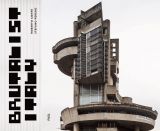Brutalist Italy: Concrete architecture from the Alps to the Mediterranean Sea

|
vyprodáno |
|
Internetová cena:
|
712,00 Kč 
|
|
Běžná cena:
|
890,00 Kč |
|
Zboží není skladem
|
Containing over 140 exclusive photographs – ranging from private homes to football stadia – across every region of the country, Brutalist Italy is the first publication to focus entirely on this subject.
What makes Italian Brutalist buildings different to their counterparts in other countries? Containing over 140 exclusive photographs – ranging from private homes to churches and cemeteries via football stadia – across every region of the country, Brutalist Italy is the first publication to focus entirely on this subject.
Architectural photographers Roberto Conte and Stefano Perego (authors of Soviet Asia) have spent the past five years travelling over 20,000 kilometres documenting the monumental concrete structures of their native country.
Brutalism – with its minimalist aesthetic, favouring raw materials and structural elements over decorative design – has a complex relationship with Italian history. After World War II, Italian architects were keen to distance themselves from fascism, without rejecting the architectural modernism that had flourished during that era. They developed a form of contemporary architecture that engaged with traditional methods and materials, drawing on uncontaminated historical references. This plurality of pasts assimilated into new constructions is a recurring feature of the country’s Brutalist buildings, imparting to them a unique identity.
From the imposing social housing of Le Vele di Scampia to the celestial Our Lady of Tears Sanctuary, Syracuse – Brutalist Italy collects the most compelling examples of this extraordinary architecture for the first time in a single volume. About the Author Roberto Conte (1980) began taking photographs in 2006. Today he works closely with architectural practices, artists and designers, specialising in documenting buildings of the 20th century – ranging from avant-garde and rationalist structures to post-war modernism, brutalism and contemporary architecture.
Stefano Perego (1984) began photographing the industrial ruins of Milan in 2006 and has since documented hundreds of abandoned sites across Europe. After visiting the former Yugoslavia, he decided to concentrate on the modernist and brutalist architecture of former socialist countries.
Adrian Forty is Emeritus Professor of the History of Architecture – The Bartlett School of Architecture, University College London
EDITORS: Damon Murray and Stephen Sorrell have been publishing critically acclaimed books on design and architecture since 2004.
         
Diskuze
Žádný příspěvek do diskuze. Přidejte svůj názor »
|


















